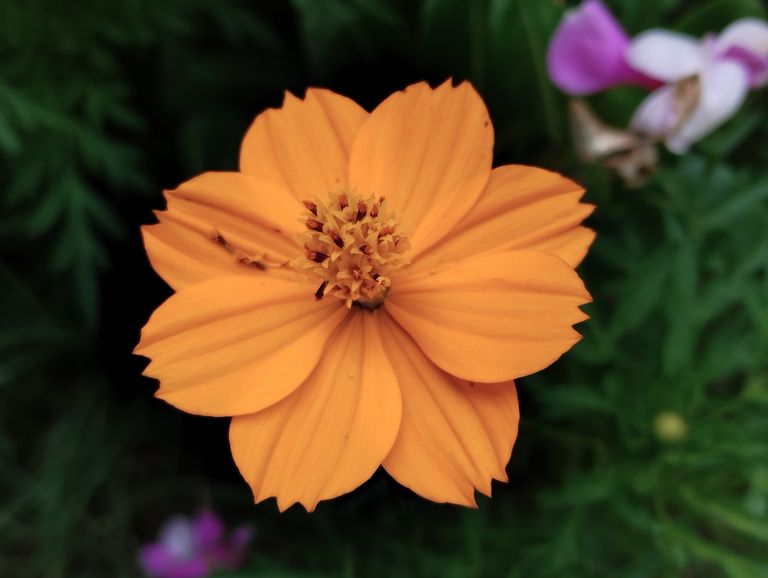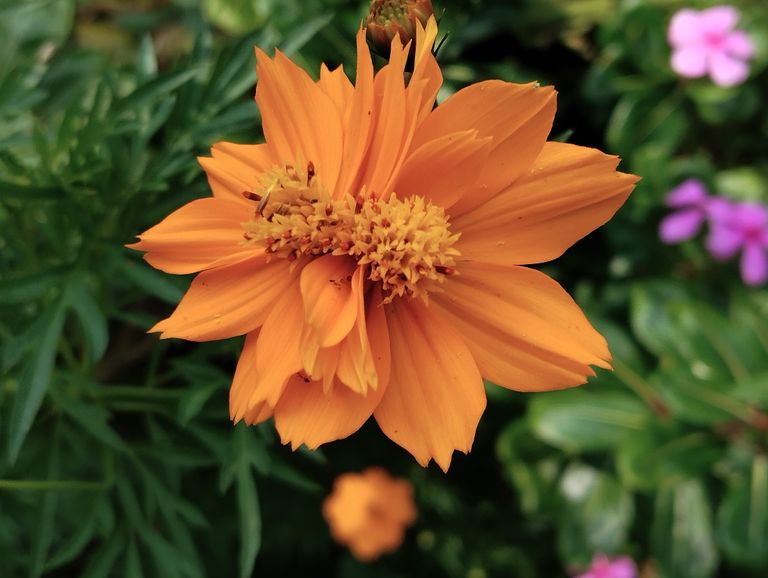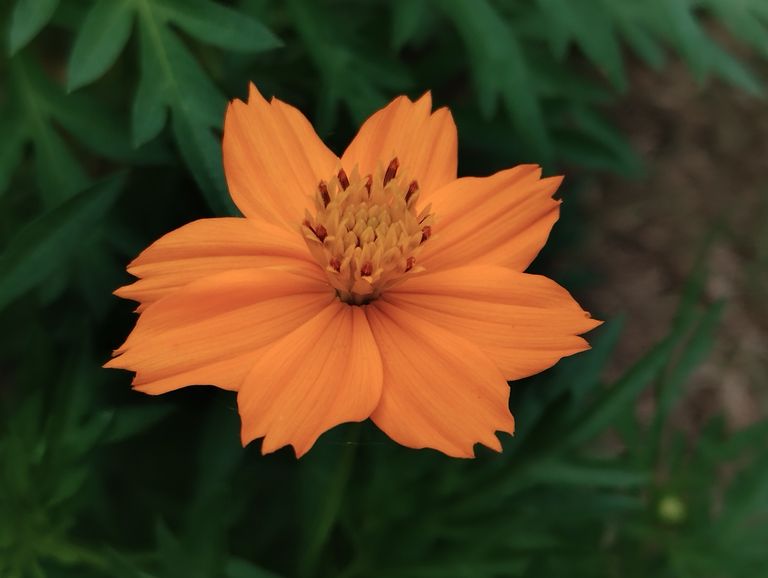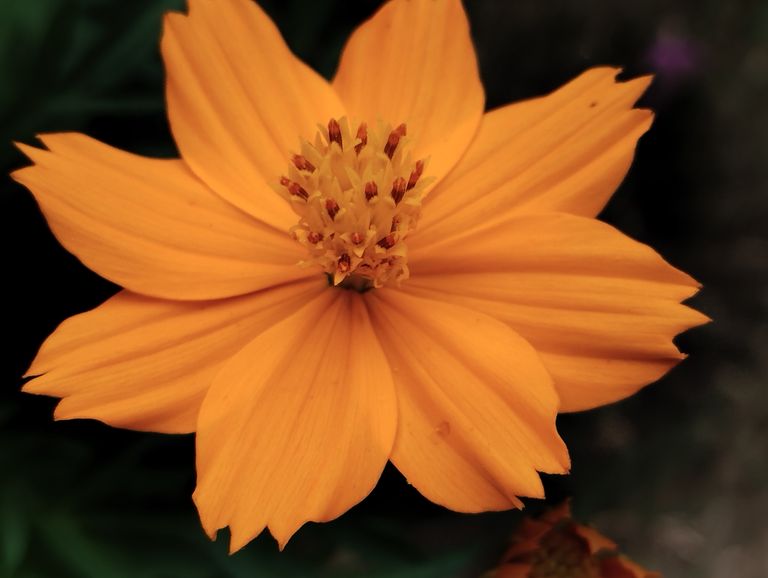The Beauty of Kasmos Flowers: A Glimpse into Nature's Elegance.

Flowers have always held a special place in our hearts, symbolizing beauty, love, and the wonders of nature. Among the myriad varieties of flowers that bloom across the globe, the Kasmose flower (often known as Cosmos flower) stands out for its delicate charm and vibrant presence. These flowers, with their intricate petals and colorful blooms, have captured the admiration of botanists, gardeners, and nature enthusiasts alike. This blog will take you through the captivating beauty of Kasmos flowers, their unique qualities, and their significance in different cultures.
Origin and History of Kasmos Flowers
The Kasmos flower belongs to the Asteraceae family, which is one of the largest plant families in the world. The name “Cosmos” is derived from the Greek word kosmos, meaning “order” or “harmony.” This name was chosen because of the flower's orderly arrangement of petals, which often appear perfectly symmetrical.
Kasmos flowers are native to Mexico, but they have spread across the world due to their adaptability and beauty. These flowers thrive in warm, sunny climates and are known for their resilience, making them a favorite among gardeners. They were first introduced to Europe in the late 16th century and have since become a popular addition to gardens across the globe.
The Aesthetic Appeal of Kasmos Flowers
Kasmos flowers are often praised for their vibrant colors, which range from pure white to deep purples and pinks. The variety of colors they exhibit makes them an excellent choice for garden landscapes, where they can be planted to create a spectrum of hues that brighten up any space. Their daisy-like appearance, coupled with their feathery foliage, gives them an air of lightness and grace.
Each flower consists of a cluster of petals that radiate from the center, often resembling a delicate sunburst. The center of the flower is typically a golden yellow, which contrasts beautifully with the surrounding petals, enhancing its visual appeal. The simplicity of the Kasmos flower’s structure, combined with its vivid colors, embodies a sense of natural elegance that is both captivating and serene.
Symbolism and Cultural Significance
Throughout history, flowers have been imbued with symbolic meanings, and the Kasmos flower is no exception. In the language of flowers, Kasmos represents order, peace, and modesty. Its balanced structure and gentle appearance make it a symbol of harmony and tranquility. The flower is often used in bouquets and floral arrangements to convey these sentiments, making it a popular choice for weddings, peaceful gatherings, and moments of reflection.
In some cultures, Kasmos flowers are associated with love and beauty. The vibrant pink and red varieties are often seen as symbols of passion and affection, while the white ones represent purity and innocence. This versatility in meaning allows the Kasmos flower to be used in various contexts, from romantic gestures to spiritual offerings.
Kasmos Flowers in Gardens and Landscaping
One of the most appealing aspects of Kasmos flowers is their ability to thrive in a variety of conditions. They are relatively low-maintenance, requiring minimal water and care, which makes them ideal for both novice and experienced gardeners. Kasmos flowers are also known for their long blooming period, which can extend from early summer to late autumn, providing continuous bursts of color throughout the growing season.
In landscaping, Kasmos flowers are often used in borders, wildflower meadows, and cottage gardens. Their tall, slender stems make them perfect for adding height and movement to garden designs, while their wide range of colors allows for creative combinations. Kasmos flowers are also excellent companions for other plants, attracting pollinators like bees and butterflies, which can help support a healthy garden ecosystem.
For those who prefer container gardening, Kasmos flowers are a wonderful choice. They can be grown in pots and placed on balconies, patios, or windowsills, where they will continue to bloom and spread their beauty. Their compact size and adaptability make them suitable for urban environments, where space is often limited.
The Eco-Friendly Nature of Kasmos Flowers
Beyond their aesthetic appeal, Kasmos flowers also play an important role in supporting biodiversity. They are known to attract a variety of pollinators, including bees, butterflies, and birds. This makes them a valuable addition to gardens that aim to support local wildlife. In a time when pollinator populations are declining, planting Kasmos flowers can contribute to the preservation of these essential species.
Kasmos flowers are also known for their ability to thrive in poor soil conditions, which reduces the need for fertilizers and chemical treatments. This makes them an eco-friendly choice for gardeners who are conscious of their environmental impact. Their drought-tolerant nature further reduces the need for excessive water usage, making them a sustainable option for gardens in areas prone to dry spells.
Growing and Caring for Kasmos Flowers
If you’re considering adding Kasmos flowers to your garden, you’ll be pleased to know that they are relatively easy to grow. They thrive in well-drained soil and require full sun to bloom at their best. Kasmos flowers can be grown from seeds, which should be sown directly into the soil after the last frost. They typically germinate within a week or two, and seedlings will begin to flower within two to three months.
One of the key aspects of caring for Kasmos flowers is ensuring that they receive enough sunlight. While they are tolerant of drought conditions, regular watering during prolonged dry periods will help keep them healthy and blooming. Deadheading, or removing spent flowers, will encourage the plants to produce more blooms and extend the flowering period.
Kasmos flowers can also be prone to legginess, where the stems become elongated and weak. To prevent this, it’s a good idea to pinch back the plants when they are young, which will promote bushier growth and more abundant flowering.
Conclusion: A Testament to Nature's Simplicity and Beauty
The Kasmos flower is a true testament to the beauty and simplicity of nature. Its vibrant colors, delicate structure, and low-maintenance nature make it a favorite among gardeners and nature lovers alike. Whether used in garden landscapes, as cut flowers, or in wildflower meadows, Kasmos flowers have a way of bringing joy and serenity to any space they inhabit.
In addition to their aesthetic appeal, Kasmos flowers also offer environmental benefits by supporting pollinators and thriving in eco-friendly conditions. Their versatility, resilience, and symbolic meaning add to their charm, making them a beloved flower that continues to inspire admiration across the world.
So, if you’re looking to add a touch of elegance and color to your garden, consider the Kasmos flower. Its beauty, grace, and enduring appeal are sure to brighten your surroundings and bring a sense of harmony to your outdoor space.


The Benefits of Kesom Leaf (Polygonum odoratum) - A Hidden Treasure
The natural world offers us a vast array of plants with medicinal and health-boosting properties. Among these is the lesser-known but immensely beneficial Kesom plant, often referred to as the Vietnamese coriander or Laksa leaf. The botanical name for Kesom is Polygonum odoratum, and it is primarily found in Southeast Asia, especially in countries like Thailand, Vietnam, and Cambodia. The leaves of the Kesom plant are widely used in traditional medicine and culinary practices. However, this plant is not just a flavor enhancer; it holds numerous health benefits that many might not be aware of.
In this blog, we’ll dive deep into the various health benefits of Kesom leaves and why they should find a place in your diet and daily wellness routine.
Nutritional Profile of Kesom Leaves
Kesom leaves, like many other herbs, are packed with vital nutrients. Some of the key nutrients found in these leaves include:
- Antioxidants: These help combat oxidative stress and neutralize free radicals in the body.
- Vitamin C: Known for boosting immunity and skin health.
- Flavonoids: These compounds have anti-inflammatory, antiviral, and antioxidant properties.
- Essential Oils: The leaves are rich in aromatic compounds that have both medicinal and aromatic benefits.
1. Anti-Inflammatory Properties
One of the standout features of Kesom leaves is their anti-inflammatory potential. Inflammation is at the root of many chronic diseases, including arthritis, cardiovascular diseases, and diabetes. Regular consumption of Kesom leaves can help in reducing inflammation, thereby potentially lowering the risk of these chronic conditions.
How to use: Add fresh Kesom leaves to salads, soups, or as a garnish in dishes. The fresh leaves not only add a citrusy flavor but also provide a direct intake of its anti-inflammatory benefits.
2. Digestive Health
Kesom leaves have been traditionally used to aid digestion. The essential oils present in the leaves help in stimulating the digestive enzymes, making the digestion process smoother. In Southeast Asia, Kesom is often added to food to help in the digestion of rich and fatty meals, especially in heavy dishes like laksa.
Tip for use: A tea made from Kesom leaves can be sipped after meals to help reduce bloating and indigestion. Simply steep a few fresh leaves in hot water for 5-10 minutes.
3. Antimicrobial Effects
The essential oils and other bioactive compounds in Kesom leaves have been found to exhibit antimicrobial properties. This makes the leaves effective against certain bacteria and fungi. In traditional medicine, Kesom leaves have been used to treat wounds and skin infections because of their antimicrobial properties.
Traditional Use: In some regions, crushed Kesom leaves are applied directly to minor wounds or skin irritations as a natural remedy to prevent infections.
4. Heart Health and Blood Pressure Regulation
Kesom leaves have been found to have a positive impact on heart health. The plant contains potassium, which is known to help regulate blood pressure. Additionally, the anti-inflammatory properties of the leaves help in preventing inflammation of the blood vessels, thus promoting better cardiovascular health.
How to include in diet: Consuming Kesom leaves regularly in dishes or as a herbal tea can contribute to better heart health. The leaves are a common addition to heart-healthy meals in traditional Vietnamese and Thai cuisine.
5. Weight Management
For those looking to manage their weight naturally, Kesom leaves might be a helpful ally. The leaves have a mild diuretic effect, which can help the body eliminate excess water. Additionally, the leaves can also help in boosting metabolism due to their rich essential oil content, making them a great addition to a weight management regimen.
How to consume: Adding Kesom leaves to salads, or drinking a mild infusion of the leaves, can support weight loss efforts by promoting better digestion and metabolism.
6. Anti-Anxiety and Stress Relief
Apart from its physical health benefits, Kesom leaves are also beneficial for mental well-being. The aroma of the essential oils found in Kesom has been shown to have calming effects. These leaves have been used in traditional medicine to reduce stress, anxiety, and even promote better sleep.
Use in aromatherapy: You can make an infusion of the leaves and add it to your bath, or crush a few leaves and inhale the soothing scent to alleviate anxiety.
7. Skin Health and Anti-Aging Benefits
Kesom leaves are rich in antioxidants and vitamin C, both of which are essential for skin health. These compounds help in neutralizing free radicals that contribute to aging, thereby preventing wrinkles and other signs of aging. Vitamin C also plays a role in collagen production, which is vital for maintaining the skin's elasticity and youthful appearance.
DIY Face Mask: Crush fresh Kesom leaves and mix with a little honey. Apply the mixture to your face and leave it on for 10-15 minutes before rinsing. This natural face mask can help rejuvenate your skin and give it a radiant glow.
8. Blood Sugar Regulation
For individuals with diabetes or those at risk, Kesom leaves can be a valuable dietary addition. The anti-inflammatory properties of the leaves, combined with their ability to help regulate blood sugar levels, make them beneficial in managing diabetes.
Tip for use: Regular consumption of Kesom leaves in food or as a tea can help maintain healthy blood sugar levels. However, it’s important to consult a doctor before making significant dietary changes, especially for those with medical conditions like diabetes.
9. Boosting Immunity
With its high antioxidant content, Kesom leaves help strengthen the immune system. Antioxidants play a crucial role in protecting the body against infections by neutralizing harmful free radicals and promoting overall cellular health.
How to incorporate: To boost your immune system, try adding fresh Kesom leaves to your daily meals. They can be incorporated into salads, soups, and even smoothies for an added health boost.
10. Menstrual Pain Relief
In some traditional medicines, Kesom leaves are used as a remedy for menstrual cramps and discomfort. The anti-inflammatory and antispasmodic properties of the leaves help in relieving pain and cramps associated with menstruation.
How to use: A warm infusion of Kesom leaves can be consumed during menstruation to help alleviate pain and reduce cramping.
Conclusion
Kesom leaves may not be as well-known in many parts of the world, but their health benefits are undeniable. From promoting digestive health to providing relief from anxiety and aiding in skin care, these leaves are truly a treasure trove of natural goodness. If you haven’t already, consider incorporating Kesom leaves into your diet and daily wellness routine. As with all herbal remedies, it's important to use them in moderation and consult a healthcare professional if you have any underlying health concerns.
Whether used in cooking, skincare, or as a medicinal herb, Kesom leaves offer a wide range of health benefits that can improve overall well-being. This natural plant is a testament to the power of nature and its ability to heal and nourish the body from the inside out.


Medicinal Benefits of the Kasom Flower
The Kasom flower, known for its vibrant beauty and unique fragrance, is not just admired for its ornamental value. It holds significant medicinal properties that have been used in traditional medicine systems for centuries. This flower, commonly found in various regions of Asia, particularly in India and neighboring countries, is a natural source of healing and wellness. In this blog, we will explore the medicinal benefits of the Kasom flower and how it can be used to improve health.
1. Anti-inflammatory Properties
One of the most important medicinal uses of the Kasom flower is its anti-inflammatory properties. The extracts from this flower are often used to reduce inflammation in the body. This makes it highly effective in treating conditions like arthritis, muscle pain, and even external wounds. Traditional healers have long used the flower in poultices and salves to alleviate swelling and pain.
The active compounds in the flower help to inhibit the enzymes responsible for inflammation, thereby providing relief from chronic inflammatory conditions. Regular use of Kasom flower extracts can help in reducing the symptoms of arthritis and other inflammatory diseases without the side effects associated with conventional medication.
2. Rich in Antioxidants
The Kasom flower is packed with antioxidants, which are crucial in fighting oxidative stress in the body. Oxidative stress can lead to cellular damage, which in turn accelerates aging and can contribute to various diseases, including cancer, cardiovascular diseases, and neurodegenerative conditions.
The antioxidants present in the Kasom flower neutralize free radicals, preventing them from causing harm. This not only helps in maintaining youthful skin but also plays a significant role in preventing chronic illnesses. The flower is often used in teas and herbal supplements for its antioxidant benefits.
3. Antibacterial and Antifungal Properties
Another significant benefit of the Kasom flower is its ability to fight bacterial and fungal infections. The flower contains natural compounds that inhibit the growth of harmful bacteria and fungi, making it a potent remedy for skin infections, wounds, and other related conditions.
Topical application of Kasom flower extracts can help treat infections, especially those caused by bacteria such as Staphylococcus aureus and fungi like Candida. In traditional medicine, it is commonly used to treat skin conditions like eczema, ringworm, and athlete’s foot.
4. Promotes Digestive Health
In traditional medicine, the Kasom flower has been used to promote digestive health. The flower’s natural compounds aid in the digestive process by stimulating the production of digestive enzymes, which can help prevent indigestion, bloating, and gas.
It is also known to have mild laxative properties, making it beneficial for individuals suffering from constipation. Consuming Kasom flower-infused teas or supplements can regulate bowel movements and ensure a healthy digestive system.
5. Supports Respiratory Health
The Kasom flower is also widely recognized for its ability to support respiratory health. In traditional medicine, it has been used to treat conditions like asthma, bronchitis, and common colds. The flower’s natural anti-inflammatory and antimicrobial properties help in clearing the respiratory tract, reducing mucus, and easing breathing.
Drinking Kasom flower tea or using its extracts in inhalants can provide relief from respiratory problems. It helps in soothing the throat and reducing the severity of coughs and colds.
6. Improves Skin Health
Kasom flower extracts are commonly used in skincare products due to their ability to improve skin health. The flower’s antioxidant and anti-inflammatory properties help in treating various skin conditions like acne, eczema, and psoriasis. It also helps in reducing the appearance of fine lines and wrinkles, promoting youthful, glowing skin.
Regular use of Kasom flower-based skincare products can enhance the skin's texture, reduce blemishes, and protect the skin from environmental damage.
7. Boosts Immune System
The immune-boosting properties of the Kasom flower make it a powerful natural remedy for improving overall health. The flower contains compounds that stimulate the production of white blood cells, which play a crucial role in defending the body against infections.
Consuming Kasom flower extracts regularly can help in strengthening the immune system, reducing the frequency of illnesses like colds, flu, and other infections. It also helps the body recover faster from illnesses.
8. Reduces Stress and Anxiety
Kasom flower has mild sedative properties, which makes it beneficial in reducing stress and anxiety. In traditional medicine, it has been used to calm the mind and promote relaxation. The flower’s soothing aroma can help in alleviating tension and improving mood.
Many people use Kasom flower essential oils in aromatherapy to relieve stress, anxiety, and even insomnia. It helps in balancing the body’s stress hormones, providing a sense of calm and tranquility.
9. Cardiovascular Health
The antioxidants present in the Kasom flower are also known to support cardiovascular health. Regular consumption of the flower’s extracts can help in reducing cholesterol levels, improving blood circulation, and maintaining healthy blood pressure levels. This reduces the risk of heart diseases, such as heart attacks and strokes.
The flower’s ability to prevent oxidative damage to blood vessels ensures that the heart and circulatory system function optimally.
10. Detoxification
Kasom flower has natural detoxifying properties that help in cleansing the body from harmful toxins. The flower promotes the elimination of toxins from the liver and kidneys, ensuring that the body remains healthy and free from harmful substances.
By incorporating Kasom flower extracts into your diet, you can aid your body’s natural detoxification process and improve your overall well-being.
How to Use Kasom Flower
There are various ways to use the Kasom flower for its medicinal benefits:
Teas: Kasom flower tea is one of the most common ways to consume this flower. It is brewed using dried flowers and can be consumed daily to enjoy its health benefits.
Essential Oils: The flower’s essential oil can be used for aromatherapy, massages, or added to bathwater to reduce stress and anxiety.
Poultices and Salves: For external use, Kasom flower extracts can be mixed with carrier oils and applied directly to the skin to treat infections and inflammation.
Supplements: Kasom flower supplements are available in capsule or powder form, offering an easy way to incorporate the flower into your daily routine.
Conclusion
The Kasom flower is a treasure trove of medicinal benefits. From its anti-inflammatory and antioxidant properties to its ability to support digestive, respiratory, and cardiovascular health, this flower is a natural remedy that can improve overall well-being. Whether used in teas, essential oils, or supplements, the Kasom flower offers a wide range of health benefits without the side effects of conventional medicines. As more research continues to uncover its potential, it is clear that this humble flower holds great promise in natural medicine.
Telegram and Whatsapp